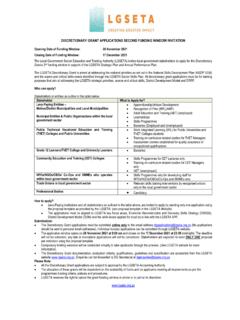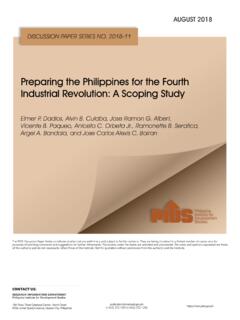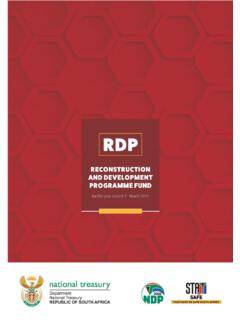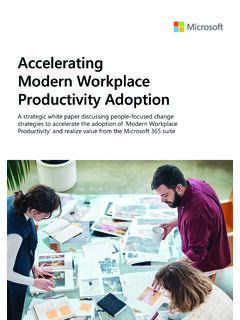Transcription of The Fourth Industrial Revolution: Opportunities and …
1 International Journal of Financial Research Vol. 9, No. 2; 2018 Published by Sciedu Press 90 ISSN 1923-4023 E-ISSN 1923-4031 The Fourth Industrial revolution : Opportunities and Challenges Min Xu1, Jeanne M. David2 & Suk Hi Kim1 1 Department of Finance, College of Business Administration, University of Detroit Mercy, Detroit, MI, USA 2 Department of Accounting, College of Business Administration, University of Detroit Mercy, Detroit, MI, USA Corresponddence: Min Xu, Associate Professor of Finance, College of Business Administration, University of Detroit Mercy, Detroit, MI 48221, USA. Tel: 313-993-1225. Received: February 16, 2018 Accepted: March 6, 2018 Online Published: March 8, 2018 URL: Abstract The Fourth Industrial revolution , a term coined by Klaus Schwab, founder and executive chairman of the World Economic Forum, describes a world where individuals move between digital domains and offline reality with the use of connected technology to enable and manage their lives.
2 (Miller 2015, 3) The first Industrial revolution changed our lives and economy from an agrarian and handicraft economy to one dominated by industry and machine manufacturing. Oil and electricity facilitated mass production in the second Industrial revolution . In the third Industrial revolution , information technology was used to automate production. Although each Industrial revolution is often considered a separate event, together they can be better understood as a series of events building upon innovations of the previous revolution and leading to more advanced forms of production. This article discusses the major features of the four Industrial revolutions, the Opportunities of the Fourth Industrial revolution , and the challenges of the Fourth Industrial revolution . Keywords: Fourth Industrial revolution , five ages of civilization, 3D printing technology, artificial intelligence, IoT, fusion of technology, robotics 1.
3 Introduction The speed and measure of the changes coming about by the Fourth Industrial revolution are not to be ignored. These changes will bring about shifts in power, shifts in wealth, and knowledge. Only in being knowledgeable about these changes and the speed in which this is occurring can we ensure that advances in knowledge and technology reach all and benefit all. The first Industrial revolution started in 1760 with the invention of the steam engine. The steam engine allowed the transition from farming and feudal society to the new manufacturing process. This transition included the use of coal as the main energy while trains were the main means of transportation. Textile and steel were the dominant industries in terms of employment, value of output, and capital invested. The second Industrial revolution began in 1900 with the invention of the internal combustion engine. This led to an era of rapid industrialization using oil and electricity to power mass production.
4 The third Industrial revolution started in 1960 and was characterized with the implementation of electronics and information technology to automate production. Under the old ways, making things involved screwing or welding lots of parts together. The Fourth Industrial revolution now involves computer generated product design and three dimensional (3D) printing, which can create solids object by building up successive layers of materials. (Prisecaru, 57-62) Table 1 shows a short presentation of the Industrial revolutions from 1760 to the present. International Journal of Financial Research Vol. 9, No. 2; 2018 Published by Sciedu Press 91 ISSN 1923-4023 E-ISSN 1923-4031 Table 1. Main characteristics of Industrial revolutions Period Transition Period Energy Resource Main Technical Achievement Main Developed Industries Transport Means I: 1760-1900 1860-1900 Coal Steam Engine Textile, Steel Train II: 1900-1960 1940-1960 Oil Electricity Internal Combustion Engine Metallurgy, Auto, Machine Building Train, Car III: 1960-2000 1980-2000 Nuclear Energy Natural Gas Computers, Robots Auto, Chemistry Car, Plane IV: 2000- 2000-2010 Green Energies Internet, 3D Printer, Genetic Engineering High Tech Industries Electric Car, Ultra-Fast Train Source: Prisecaru, P.
5 (2016). "Challenges of the Fourth Industrial revolution ." Knowledge Horizons. Economics, 8(1), 57-62. Web :2443/docview/1793552558?accountid=28018 . Now a Fourth Industrial revolution is building on the Third, the digital revolution that has been occurring since the middle of the last century. It is characterized by a fusion of technologies that is blurring the lines between the physical, digital, and biological spheres. There are three reasons why today s transformations represent not merely a prolongation of the Third Industrial revolution but rather the arrival of a Fourth and distinct one: velocity, scope, and systems impact. The speed of current breakthroughs has no historical precedent. When compared with previous Industrial revolutions, the Fourth is evolving at an exponential rather than a linear pace. Moreover, it is disrupting almost every industry in every country. And the breadth and depth of these changes herald the transformation of entire systems of production, management, and governance.
6 (Schwab 2015) 2. Opportunities of the Fourth Industrial revolution There are similarities between four Industrial revolutions and the five ages of civilization: the hunter and gather age, the agricultural age, the Industrial age, the information worker age, and the emerging age of wisdom. Therefore, we may infer the Opportunities of the Fourth Industrial revolution through the characteristics of these five ages of civilization presented by Steven Covey in his book 8th Habit. (2011, 12-17) First, the productivity of each subsequent age goes up fifty times over the preceding age. Consider for example, the increase in productivity of the Industrial age over the agricultural age. Second, each subsequent age destroys many of the jobs of the preceding age. The information age is replacing the jobs created by the Industrial age. Much of losses in our Industrial age jobs have less to do with government policy and free trade agreements than they do with dramatic shift in our economy to the knowledge worker.
7 Third, in the first three ages of civilization manual workers produced most goods and services with their body, but in the last two ages, knowledge workers produce most goods and services with their mind. Knowledge workers are the link to a company's other investments. They provide focus, creativity, and leverage in using those investments to achieve the organization s objectives more efficiently. In other words, knowledge is an integral part of total management and cuts across functional boundaries. The main assets and primary drivers of the Industrial age were machines and capital. People were necessary but replaceable. The management style of the Industrial age simply does not work in the new economy. Management focused on motivating employees to perform the physical labor needed to produce the products and services. In the Fourth Industrial age, the challenge now is how companies can motivate their knowledge workers to release their human potential.
8 Leading researchers argue that the Fourth Industrial revolution will shape the future through its impacts on government and business. People have no control over either technology or the disruption that comes with the Fourth Industrial revolution . However, we can predict the Opportunities that comes with the Fourth Industrial revolution : 1) lower barriers between inventors and markets, 2) more active role for the artificial intelligence (AI), 3) integration of different technics and domains (fusion), 4) improved quality of our lives (robotics) and 5) the connected life (Internet). International Journal of Financial Research Vol. 9, No. 2; 2018 Published by Sciedu Press 92 ISSN 1923-4023 E-ISSN 1923-4031 First, Chris Anderson predicts that the Fourth Industrial revolution is likely to reduce barriers between inventors and markets due to new technologies such as 3D printing for prototyping.
9 (2012) For example, tissue engineers use rapid prototyping techniques to produce 3D porous scaffolds. The 3D printing technique fabricates scaffolds with a novel micro- and macro-architecture and these in turn help shape the new tissue as it regenerates. New technologies, like this 3D printing, allow entrepreneurs with new ideas to establish small companies with lower start-up costs. The entrepreneur can bring the product 'to reality' with 3D printing, without the traditional time constraints often encountered with traditional prototyping methods. The typical barriers to entry are removed from the marketing equation. Second, increasing trends in artificial intelligence point to significant economic disruptions in the coming years. Artificial systems that rationally solve complex problems pose a threat to many kinds of employment, but also offers new avenues to economic growth. A report by McKinsey & Company found that half of all existing work activities would be automated by currently existing technologies, thereby enabling companies to save billions of dollars and to create new types of jobs .
10 (Manyika et al. 2017) For example, driverless cars may modestly replace tax and Uber drivers, but autonomous trucks may radically transform shipping with far fewer jobs for truck drivers. Third, innovative technologies will integrate different scientific and technical disciplines. Key forces will come together in "a fusion of technologies that is blurring the lines between physical, digital, and biological spheres." (Schwab 2015) This fusion of technologies goes beyond mere combination. Fusion is more than complementary technology, because it creates new markets and new growth Opportunities for each participant in the innovation. It blends incremental improvements from several (often previously separated) fields to create a product. Fourth , robotics can and will change our lives in the near future. Technically robots are automated motorized tools. They cook food, play our music, record our shows, and even run our cars.










